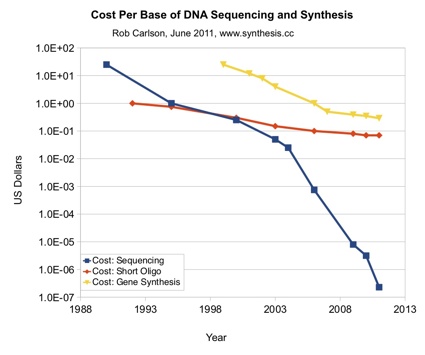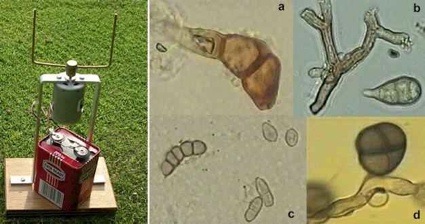The premise of Raphael Kim‘s project at Design Interactions‘ work in progress show –which closed a couple of days ago at the Royal College of Art– contained all the ingredients to intrigue me: The falling cost and increase in speed of DNA sequencing has given rise to two extreme scientific worlds: giant pharmaceutical companies who trawl the Arctic Ocean in search of potent genes that would profit them in a lucrative cancer market; and DIY biologists who try to beat the system.
The designer imagined a gene hunting device that biohackers (who usually cannot afford to ‘trawl’ the oceans) would create to collect gene samples present in the air.
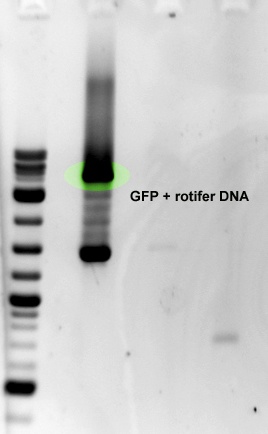
The device would rely on rotifers, tiny animals capable of absorbing environmental DNA, that have been genetically programmed to start glowing as soon as a target gene is spotted in their environment. The rotifers sit inside a chamber attached to the gene hunting device, and wait for the targets to come near. This kind of “LED switch” can be obtained by fusing a commercially-available fluorescent gene with a part of rotifer’s own DNA (see image on the left).
A motor spins at high speed to draw the air onto the sampler while the outer mesh of the device protects the delicate samplers and filters out large, unwanted particles.
In-line with biohacking philosophy, these actions can be done, in theory, using an open-source data and hardware available to the public. Ever since the complete DNA sequence of human has been made public, genetic maps of other organisms have been published gradually, including those of rotifers, on free online database such as GenBank. Many other pieces of biohacking equipment can either be made at home or can be purchased on eBay.
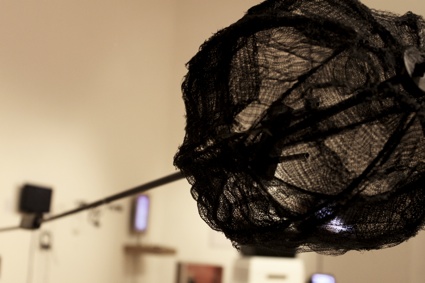 The gene hunting device. Image courtesy Raphael Kim
The gene hunting device. Image courtesy Raphael Kim
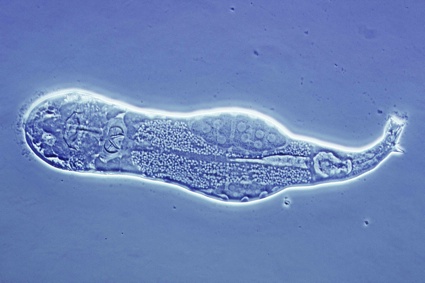 Rotifer. Image courtesy Raphael Kim
Rotifer. Image courtesy Raphael Kim
Unsurprisingly, i left the show with many questions for Raphael:
The description of your project in the show mentions the ‘falling cost and increase in speed of DNA sequencing’, so how cheap and how fast can this be done nowadays? do you mean ‘cheap’ for corporate labs or do you mean ‘so cheap that anyone can do it’?
This is a ‘Carlson’s curve’ that monitors cost of DNA sequencing over time (see blue line). At the moment, my understanding is that for each base of DNA it would cost you a fraction of a penny. The cost of DNA synthesis (the act of actually creating new strands of DNA) is falling as well, albeit relatively slower (red and yellow lines).
If we think about sequencing the entire genomes of organisms, the cost can be huge for an average biohacker. Humans, with three billion base pairs of genomic DNA, would cost just below $20,000 using the latest sequencing technology, and even a relatively simpler E.coli bacterial genome would be costly. However, most biohack projects do not need to involve the entire genome, but a selection of few genes from its massive catalog. These are in the regions of hundreds to thousands of bases, which brings the cost down to a manageable level, and they can be sequenced by commercial companies that can take your sample away and sequence them for you on your behalf.
Some companies even offer an overnight sequencing service, that would allow them to sequence around 1,400 bases of your sample through the night. So yes, the speed is there, and also affordable for ordinary people to carry out.
This is already happening in citizen science. DIY bio groups in Europe have already started to create microbe maps – by collecting samples from various parts of a city and analyzing them they are trying to paint a picture of microbial diversity in a given area.
It is also important I think that whilst low cost of sequencing and synthesis is a significant trend that allows biohackers to explore the genetic contents of their environment, it is only a part of a bigger economical landscape in which ‘biohacking’ practice as a whole, sits in. In fact, most biohack projects do not involve DNA sequencing at all, as they can buy cheap, ready made DNA components and templates for use (think of it as components of an electric circuit board – resisters, amplifiers, LEDs etc), as well as cheap second hand lab equipment bought from ebay, sold by pharma companies who are going bankrupt from the credit crunch.
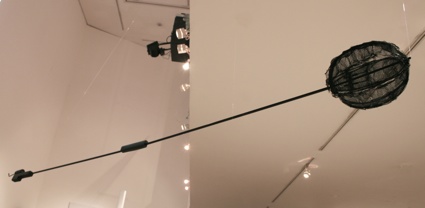 The gene hunting device. Image courtesy Raphael Kim
The gene hunting device. Image courtesy Raphael Kim
The gene hunting device you’re showing would thus be used by a citizen to do their own gene hunting. Does it look in any way like the tools used by pharmaceutical companies? Do you know which kind of instruments they use to discover new genes?
If we think about what kind of genes we are looking for, what kind of organism these genes sit in, and where they might live, the design of the collecting device can be extremely diverse. At present, most gene-hunting is targeted at micro-organisms, such as bacteria, fungi, protozoa and planktons, which narrows it down a little.
For solid surfaces (e.g. skin, soil etc), the ‘device’ would simply consist of a cotton swab which is enough to pick up microbes. These swabs would then be sealed and taken to a big machine in laboratory for analysis. For water samples, they would use some kind of filter/net system to filter out biological samples according to size. The Craig Venter research group use specialized equipment which can be found here.
As for sampling air, which the device that I am showing at the moment is doing, simple machines called rotorod samplers are used in industry, as shown below:
They consist of rotating rods powered by motor. The rods are covered in sticky material for the microbes to land on, which can be analysed.
The story I am working on is a device based on this technology. The idea is that the biohackers gather around a fish market, trying to pick up exotic microbes that become airborne from drying and decaying fish. And the rotating rods are found at the end of the device as shown below.
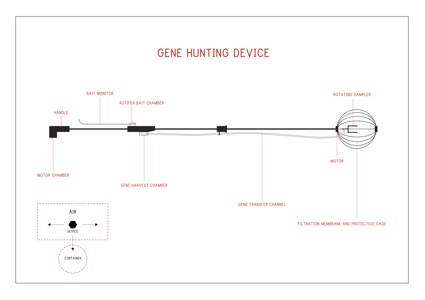 The gene hunting device. Image Raphael Kim and Jae Yeop Kim
The gene hunting device. Image Raphael Kim and Jae Yeop Kim
The air is a seemingly-unlikely source of microbes, but recent studies show that it contains abundance of them, and who knows if these could come from different parts of the world? The bacteria that coexist with fish – either living/found on its skin, or inside their stomach (ingested as food) or simply in contact with parts of the ship etc. or any other possible sources could possibly become airborne once it reaches the fish market.
I think it is important to remember that this is purely a sampling device – this device does not sequence the DNA of the captured sample for you, but merely makes some form of ‘contact’ with the target.
A bit of imagination was used to design the rest of my object – how long should they be to reach pallets of fish in the market, how could they imply a notion of a ‘hunting tool’, and also additionally, could they use some kind of a bait to help them capture the gene that they want? Where will the bait be positioned, how will it work?
Bait, here, is the rotifer, which leads me to your next question.
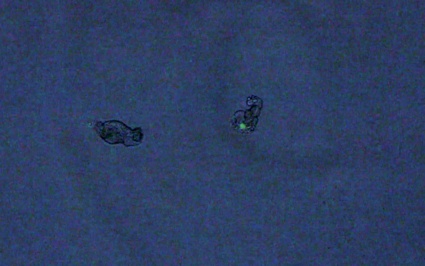 Image courtesy Raphael Kim
Image courtesy Raphael Kim
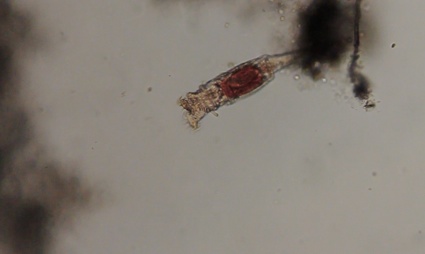 Image courtesy Raphael Kim
Image courtesy Raphael Kim
What made you think that rotifers would be the best ally of the bio hacker?
Many reasons behind this:
*Rotifers are harmless, non-toxic and non-contagious/infectious: they are animals, and not bacteria. They are made up of many different cells and are more controllable.
* Rotifers are found just about everywhere (ie. common source): If you pick up any grass or moss and put under water, these animals would be present.
* They are easy to culture and grow – just add water! (more culturing tips are found here: http://raphaelkim.tumblr.com/
* Rotifers are very robust – they can tolerate extreme dryness, cold and ioniszing radiation – an ideal set of features that are currently getting NASA people very excited.
* They can be dried and stored for future use. Below is an image of drying ‘pellets’ of rotifers which I have made. These can be ground and put into the chambers of the hunting device, and be activated when in use.
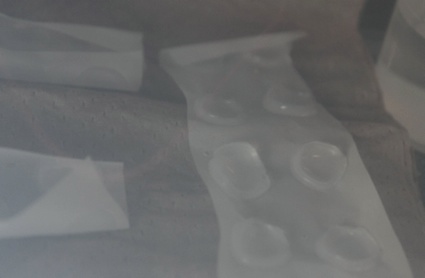 Drying rotifers. Image courtesy Raphael Kim
Drying rotifers. Image courtesy Raphael Kim
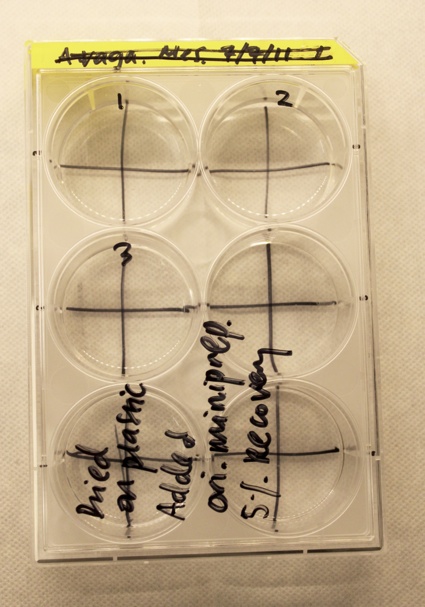 Culture plate. Image courtesy Raphael Kim
Culture plate. Image courtesy Raphael Kim
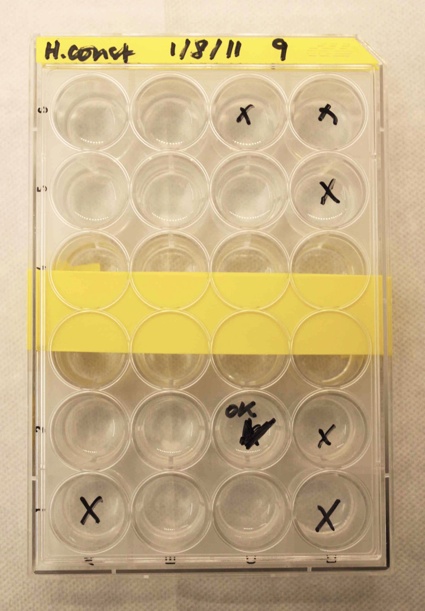 Culture plate. Image courtesy Raphael Kim
Culture plate. Image courtesy Raphael Kim
* Also – perhaps most importantly, rotifers are used because they are able to absorb environmental DNA. This is known as horizontal DNA transfer – and rotifers do this first by eating the source of DNA (eg. oncoming bacteria, plankton, yeast etc). The rotifer then needs to undergo some kind of stress – eg. heat, dryness, etc. This produces an unknown mechanism in which the rotifer ‘patches’ the DNA content of its stomach into its own genome. Using this mechanism, the hackers try to engineer a switch that can be incorporated into the animal so that when gene horizontal transfer occurs, the organism lights up as shown below:
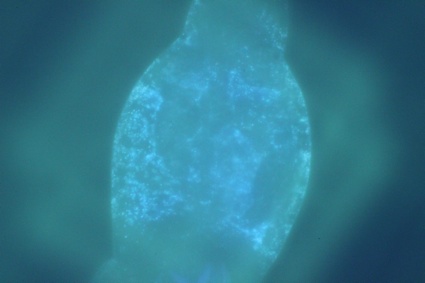 Image courtesy Raphael Kim
Image courtesy Raphael Kim
The book that is in the exhibit is a journey and experiments that were undertaken to produce this switch.
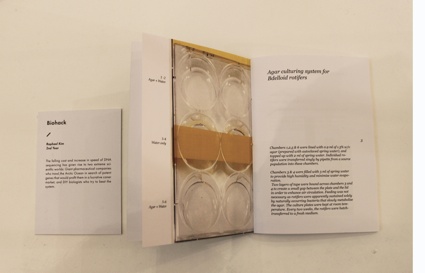 Thanks Raphael!
Thanks Raphael!

